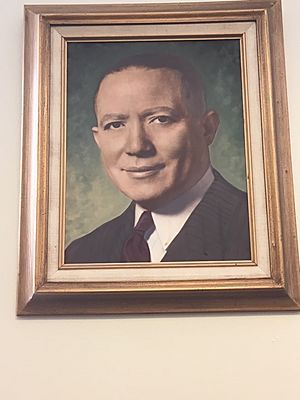Ulysses Simpson Wiggins facts for kids
Quick facts for kids
Ulysses S. Wiggins
|
|
|---|---|
 |
|
| President of the Camden County Branch NAACP | |
| In office 1941 (Co-Founder) – 1966 |
|
| Succeeded by | John W. Robinson |
| Personal details | |
| Born | 1896 Americus, Georgia |
| Died | April 8, 1966 (aged 69–70) Camden, New Jersey |
| Spouse |
Alice Turner
(m. 1933) |
| Alma mater | Lincoln University, 1918. University of Michigan, 1924. |
| Profession | Doctor |
Ulysses Simpson Wiggins (born 1896, died 1966) was an important American doctor. He was also a strong leader in the civil rights movement. He worked to make sure all people were treated fairly, no matter their race.
Dr. Wiggins led the NAACP branch in Camden County. He also led the New Jersey NAACP branches. He worked hard to end segregation in Camden's schools. Segregation meant keeping Black and white students in separate schools. Dr. Wiggins was a respected leader in his community.
Early Life and Education
Ulysses Wiggins was born in Americus, Georgia in 1896. His parents were Randall and Hannah Wiggins. He was one of ten children in his family.
After growing up in Georgia, he went to Lincoln University. There, he earned his first degree. He then studied medicine at the University of Michigan. He became a doctor in 1924.
Dr. Wiggins completed his medical training in Philadelphia and New York. In 1928, he moved to Camden to start his own medical practice. In 1933, he married Alice Turner. They lived in Camden and were active members of the Saint Augustine Episcopal Church.
Career and Community Work
When Dr. Wiggins moved to Camden, he started working at Cooper Hospital. He also opened his own doctor's office. He quickly became involved in fighting for civil rights in Camden.
In 1941, he helped start the Camden chapter of the NAACP. The NAACP is a group that works for equal rights for Black people. He led the Camden NAACP from 1941 until he passed away in 1966.
Besides being a doctor, Dr. Wiggins had other important jobs. He was a doctor for the Camden Highway Department and the Camden school system. He also worked for the New Jersey State Athletic Commission. He was a member of many medical groups at local and national levels. He even led the New Jersey State Conference of Branches of the National Medical Association.
Dr. Wiggins cared deeply about education in Camden. For many years, he worked to integrate the city's schools. This meant making sure Black and white students could go to school together. He also wanted school districts to be redrawn. This way, students would go to the school closest to their homes. He also pushed for more teachers in Camden's schools.
In 1948, the Camden NAACP, led by Dr. Wiggins, took legal action. They challenged a state agency that handled school discrimination. They even threatened to stop funding for Camden's schools. Soon after, the Camden Board of Education changed the school districts. This meant students no longer had to attend separate schools based on their race.
In 1950, Dr. Wiggins helped Martin Luther King Jr. with a civil rights case. This happened after Dr. King was refused service in Maple Shade, New Jersey.
Legacy and Honors
Ulysses Wiggins had a stroke in 1964. He recovered partly and kept working. Two years later, he had another stroke and was hospitalized. He passed away on April 8, 1966, at Cooper Hospital. He was buried in Sunset Memorial Park in Pennsauken.
After Dr. Wiggins's death, several places in Camden were named in his honor. On November 2, 1969, the Bergen Square School was renamed the Dr. Ulysses S. Wiggins Elementary School. This honored him as a leader in the city's Black community. The school is located at 4th and Mount Vernon Streets in Camden.
In the early 1970s, the Paul Robeson Library at Rutgers University-Camden started a special collection. It's called the Ulysses S. Wiggins Collection. It includes books, journals, and newspapers about African Americans and Africa. Wiggins Waterfront Park in Camden is also named after him. It is located at Riverside Drive and Martin Luther King Boulevard.

